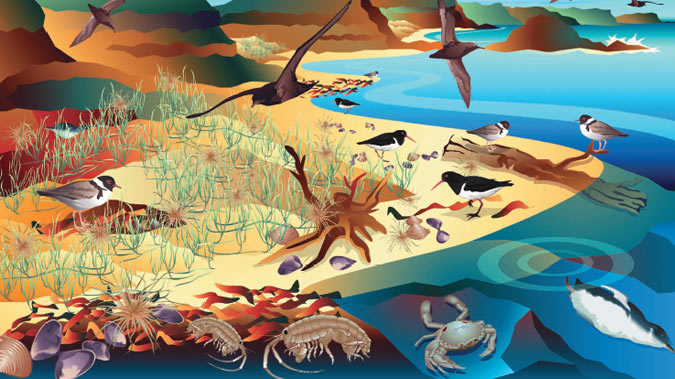Sandy Beaches and Dunes

Victoria's coast has some spectacular beaches that are important holiday destinations for many visitors. Sediment from eroding sea cliffs and materials brought down from the hills by rivers is deposited on the coast to form beaches. Longshore currents carry this material and deposit it behind rocky headlands. Sandbars that build up offshore provide a source of material for building beaches during calmer times of the year.
Where prevailing winds blow from the sea sand accumulates in piles behind the beach forming dunes that may be single or in series. Large dune systems are more common in the east of Victoria.
Far from being sandy deserts, beaches and sand dunes are home to a range of plants and animals, some of which are only found in these environments. Many small animals can live in the spaces between the sand grains in the water.
On land the vegetation on sand dunes is an important component of the coast, building and binding sand, and providing food and shelter for insects, reptiles, birds and mammals. Certain birds such as the Hooded Plover nest in sand dunes and can be seen scavenging on beaches along the coast.
Key Species

Spinifex Grass
(Spinifex sericeus)
This native grass has creeping stems and leaves covered in fine silvery hairs. Its long runners colonise and bind shifting sands on the dunes directly facing the brunt of winds. Spinifex has separate male and female plants and produces
flowers in spring. Seed pods resemble a spiny ball which are blown like tumbleweeds to spread seed.

Hooded Plover
(Thinornis (Charadrius) rubricollis)
This small Australian bird (205mm) weighs as much as a "Mars Bar" and are considered to be vulnerable to extinction. They are often seen scavenging as the waves break on the beach. Hooded Plovers nest on long flat
beaches often used by people and their dogs. To avoid disturbing nesting sites we need to keep out of the dune area and keep pets under control.

Little Penguin
(Eudyptula minor novaehollandiae)
The smallest of all penguins is a resident in locations on the Victorian coast. They feed on small fish such as pilchards. Penguins breed in burrows in vegetated sand dunes waiting until after dark before coming ashore
and usually leaving before sunrise.

Amphipods/Sandhoppers
(Talorchestia sp.)
These small crustaceans look like shrimps that have been compressed from the sides. They are common along beaches and intertidal mudflats where they can be seen jumping under dead seaweed and seagrasses. Amphipods are important
to help break down rotting vegetation and in turn they are food for many birds and fish.

Short Tailed Shearwaters
(Puffinus tenuirostris)
These agile birds use updraughts between the waves to fly enormous distances across oceans and breed in burrows in the sand dunes of southern Australia over summer, Shorttailed shearwaters migrate around the Pacific
Ocean between March and October. This migration can take its toll and many die once returning to Australian waters.

Pied Oyster Catcher
(Haematopus longirostis)
Often seen searching along the shoreline, oyster catchers can be easily recognised by their bright orange beaks and legs. Their beaks are so strong that they can break through the shells of bivalves like pipis on which
they feed. Bonding between male and female birds is strong and oyster catchers are usually seen in pairs.

Pipis
(Donax deltoides, also Paphies elongata)
Some of the most common larger animals found in sand are filter feeding bivalve molluscs, often collectively called pipis. Some species move up and down the beach carried by waves then use their muscular foot to quickly
dig down into sand. They have a tube like siphon used for taking in water for food and oxygen.

Surf Crabs
(Ovalipes austaliensis)
Surf crabs are very common in shallow water off sandy beaches buried in the sand. They are aggressive and have strong claws used to catch food and to defend themselves. Identified by the two red spots near the back of its carapace
(shell), the last pair of legs are flattened into paddles forswimming.
Habitat Close Up
Beach Washed Debris
Beachcombers will be familiar with the seaweeds and other material that are washed up onto beaches by the waves. This material represents many of the living plants and animals that live in nearby waters and give beachcombers a clue as to what could be found in the water.
Hidden amongst the seaweeds there are usually a range of natural treasures prized by beachcombers that may include shells, shark eggs or even dried sea dragons.
Seaweeds that are washed ashore are not rubbish items although they are often "cleaned" from the beach. They are an important source of food for scavengers that live in the sand. Many small crustaceans such as amphipods feed on the rotting seaweed. These animals are then food for the many species of birds such as gulls and sandpipers that search through the debris looking for them. As seaweeds decompose they contribute large amounts of detritus which is a major food source for many worms, bivalves and other scavengers. These invertebrates then become food for birds as well as fish.
Unfortunately not all material washing onto beaches is natural. Plastics and other materials that float, are often seen along with natural materials, even on remote beaches on the Victorian coast. These materials have generally come from the land via stormwater drains. Sometimes foreign material from passing or distant ships is also found in the human debris. Beachcombers should take care to avoid human materials such as syringes or glass that may cause serious injury.
So next time you go for a walk along the beach, stop and have a closer look at the debris cast up by the waves, and carefully search through it for some of the hidden treasures from the sea.
For more information or to visit some of these magnificent marine habitats, please contact the:
Marine and Freshwater Discovery Centre, Queenscliff
Ph: 03 5258 3344
Email: marine.discovery@vfa.vic.gov.au
